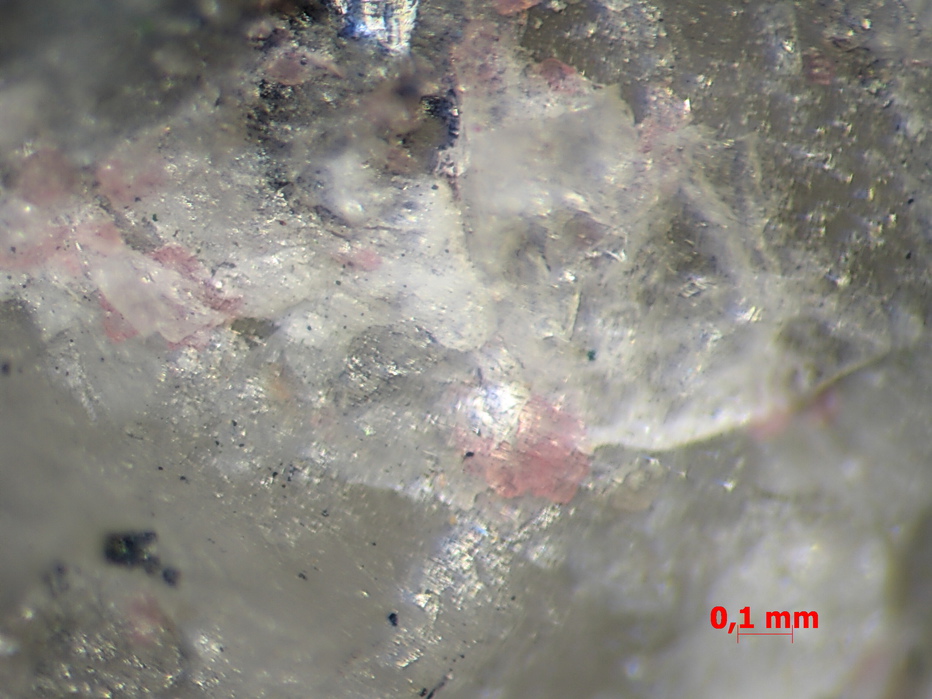Pakhomovskyite
A valid IMA mineral species
This page is currently not sponsored. Click here to sponsor this page.
About Pakhomovskyite
Formula:
Co3(PO4)2 · 8H2O
Colour:
Bright pink
Lustre:
Pearly, Dull
Hardness:
2
Specific Gravity:
2.71
Crystal System:
Monoclinic
Member of:
Name:
Named for Yakov Alekseevich Pakhomovsky (Яков Алексеевич Пахомовский) (b. 26 July 1948, Kandalaksha, Murmansk, Russia), who made significant contributions to the mineralogy of the alkaline massifs of the Kola Peninsula.
Type Locality:
This page provides mineralogical data about Pakhomovskyite.
Unique Identifiers
Mindat ID:
27472
Long-form identifier:
mindat:1:1:27472:6
GUID
(UUID V4):
(UUID V4):
7f17f19c-7d71-4b9c-ab97-b12f2f2a9e58
IMA Classification of Pakhomovskyite
Approved
Approval year:
2004
First published:
2006
Classification of Pakhomovskyite
8.CE.40
8 : PHOSPHATES, ARSENATES, VANADATES
C : Phosphates without additional anions, with H2O
E : With only medium-sized cations, RO4:H2O about 1:2.5
8 : PHOSPHATES, ARSENATES, VANADATES
C : Phosphates without additional anions, with H2O
E : With only medium-sized cations, RO4:H2O about 1:2.5
Mineral Symbols
As of 2021 there are now IMA–CNMNC approved mineral symbols (abbreviations) for each mineral species, useful for tables and diagrams.
| Symbol | Source | Reference |
|---|---|---|
| Phv | IMA–CNMNC | Warr, L.N. (2021). IMA–CNMNC approved mineral symbols. Mineralogical Magazine, 85(3), 291-320. doi:10.1180/mgm.2021.43 |
Physical Properties of Pakhomovskyite
Pearly, Dull
Transparency:
Translucent
Colour:
Bright pink
Streak:
Pink
Hardness:
2 on Mohs scale
Tenacity:
Elastic
Cleavage:
Perfect
on {010}
on {010}
Fracture:
Step-Like
Density:
2.71 g/cm3 (Measured) 2.71 g/cm3 (Calculated)
Optical Data of Pakhomovskyite
Type:
Biaxial (+)
RI values:
nα = 1.581(2) nβ = 1.600 - 2.000 nγ = 1.631(2)
2V:
Measured: 75° to 80°, Calculated: 77°
Max Birefringence:
δ = 0.050

Image shows birefringence interference colour range (at 30µm thickness)
and does not take into account mineral colouration.
and does not take into account mineral colouration.
Surface Relief:
Very High
Dispersion:
weak, r < v
Pleochroism:
Visible
Comments:
X = b, Y + c
pale pink on Y to pinkish grey on Z
pale pink on Y to pinkish grey on Z
Chemistry of Pakhomovskyite
Mindat Formula:
Co3(PO4)2 · 8H2O
Elements listed:
Common Impurities:
Mg,Mn,Ni,Fe
Crystallography of Pakhomovskyite
Crystal System:
Monoclinic
Class (H-M):
2/m - Prismatic
Space Group:
B2/m
Setting:
C2/m
Cell Parameters:
a = 10.034(4) Å, b = 13.341(3) Å, c = 4.67(3) Å
β = 105.02(2)°
β = 105.02(2)°
Ratio:
a:b:c = 0.752 : 1 : 0.35
Unit Cell V:
603.8 ų
Z:
2
Morphology:
Groups of small spherulites (up to 0.5 mm diameter) and rosettes (up to 0.05 mm diameter) of well-shaped tabular crystals.
Twinning:
none
X-Ray Powder Diffraction
Powder Diffraction Data:
| d-spacing | Intensity |
|---|---|
| 6.67 Å | (100) |
| 3.195 Å | (60) |
| 2.948 Å | (70) |
| 2.691 Å | (70) |
| 2.521 Å | (60) |
| 2.408 Å | (60) |
Comments:
Format: dobs/Å (Iobs/%) (hkl),
from type description
from type description
Geological Environment
Paragenetic Mode(s):
| Paragenetic Mode | Earliest Age (Ga) |
|---|---|
| Near-surface Processes | |
| 22 : Hydration and low-𝑇 subsurface aqueous alteration (see also #23) | |
| Stage 4b: Highly evolved igneous rocks | >3.0 |
| 36 : Carbonatites, kimberlites, and related igneous rocks |
Type Occurrence of Pakhomovskyite
General Appearance of Type Material:
groups (up to 3 x 3 x 2 cm) of small spherulites (up to 0.5 mm diameter) and rosettes (up to 0.05 mm diameter) of tabular crystals, growing on walls of leached fissures in dolomitic carbonatite
Place of Conservation of Type Material:
The Mineralogical Museum, St. Petersburg State University, Russia.
The Geological and Mineralogical Museum, Geological Institute, Kola Science Center, Russian Academy of Sciences, Apatity, Russia.
The Geological and Mineralogical Museum, Geological Institute, Kola Science Center, Russian Academy of Sciences, Apatity, Russia.
Geological Setting of Type Material:
dolomite carbonatite cutting phosphorites
Associated Minerals at Type Locality:
Reference:
Yakovenchuk, V.N., Ivanyuk, G.Yu., Mikhailova, Yu, A., Selivanova, E.A., Krivovichev, S.V. (2006) Pakhomovskyite, Co3(PO4)2·8H2O, a new mineral species from Kovdor, Kola Peninsula, Russia. The Canadian Mineralogist: 44: 117-123.
Synonyms of Pakhomovskyite
Other Language Names for Pakhomovskyite
Relationship of Pakhomovskyite to other Species
Member of:
Other Members of this group:
| Annabergite | Ni3(AsO4)2 · 8H2O | Mon. 2/m : B2/m |
| Arupite | Ni3(PO4)2 · 8H2O | Mon. 2/m : B2/m |
| Babánekite | Cu3(AsO4)2 · 8H2O | Mon. 2/m : B2/m |
| Barićite | (Mg,Fe)3(PO4)2 · 8H2O | Mon. 2/m : B2/m |
| Erythrite | Co3(AsO4)2 · 8H2O | Mon. 2/m : B2/m |
| Erythrite-Köttigite Series | ||
| Hörnesite | Mg3(AsO4)2 · 8H2O | Mon. 2/m : B2/m |
| Köttigite | Zn3(AsO4)2 · 8H2O | Mon. 2/m : B2/m |
| Manganohörnesite | Mn2+3(AsO4)2 · 8H2O | Mon. 2/m : P2/m |
| Monteneroite | Cu2+Mn2+2(AsO4)2 · 8H2O | Mon. 2/m : B2/m |
| Parasymplesite | Fe2+3(AsO4)2 · 8H2O | Mon. 2/m : B2/m |
| Vivianite | Fe2+Fe2+2(PO4)2 · 8H2O | Mon. 2/m : B2/m |
Related Minerals - Strunz-mindat Grouping
| 8.CE.X | Babánekite | Cu3(AsO4)2 · 8H2O |
| 8.CE. | Monteneroite | Cu2+Mn2+2(AsO4)2 · 8H2O |
| 8.CE.05 | Chudobaite | (Mg,Zn)5(AsO4)2(HAsO4)2 · 10H2O |
| 8.CE.05 | Geigerite | Mn2+5(AsO4)2(HAsO4)2 · 10H2O |
| 8.CE.10 | Newberyite | Mg(PO3OH) · 3H2O |
| 8.CE.15 | Brassite | Mg(HAsO4) · 4H2O |
| 8.CE.20 | Phosphorrösslerite | Mg(PO3OH) · 7H2O |
| 8.CE.20 | Rösslerite | Mg(HAsO4) · 7H2O |
| 8.CE.25 | Metaswitzerite | Mn2+3(PO4)2 · 4H2O |
| 8.CE.25 | Switzerite | Mn2+3(PO4)2 · 7H2O |
| 8.CE.30 | Lindackerite | CuCu4(AsO4)2(HAsO4)2 · 9H2O |
| 8.CE.30 | Ondrušite | CaCu4(AsO4)2(HAsO4)2 · 10H2O |
| 8.CE.30 | Veselovskýite | ZnCu4(AsO4)2(HAsO4)2 · 9H2O |
| 8.CE.30 | Pradetite | CoCu4(AsO4)2(HAsO4)2 · 9H2O |
| 8.CE.30 | Klajite | MnCu4(AsO4)2(HAsO4)2 · 9-10H2O |
| 8.CE.30 | Hloušekite | (Ni,Co)Cu4(AsO4)2(AsO3OH)2 · 9H2O |
| 8.CE.35 | Bobierrite | Mg3(PO4)2 · 8H2O |
| 8.CE.40 | Annabergite | Ni3(AsO4)2 · 8H2O |
| 8.CE.40 | Arupite | Ni3(PO4)2 · 8H2O |
| 8.CE.40 | Barićite | (Mg,Fe)3(PO4)2 · 8H2O |
| 8.CE.40 | Erythrite | Co3(AsO4)2 · 8H2O |
| 8.CE.40 | Ferrisymplesite | Fe3+3(AsO4)2(OH)3 · 5H2O |
| 8.CE.40 | Hörnesite | Mg3(AsO4)2 · 8H2O |
| 8.CE.40 | Köttigite | Zn3(AsO4)2 · 8H2O |
| 8.CE.40 | Manganohörnesite | Mn2+3(AsO4)2 · 8H2O |
| 8.CE.40 | Parasymplesite | Fe2+3(AsO4)2 · 8H2O |
| 8.CE.40 | Vivianite | Fe2+Fe2+2(PO4)2 · 8H2O |
| 8.CE.45 | Symplesite | Fe2+3(AsO4)2 · 8H2O |
| 8.CE.50 | Cattiite | Mg3(PO4)2 · 22H2O |
| 8.CE.55 | Koninckite | Fe3+PO4 · 3H2O |
| 8.CE.60 | Kaňkite | FeAsO4 · 3.5H2O |
| 8.CE.60 | Hilarionite | Fe3+2(SO4)(AsO4)(OH) · 6H2O |
| 8.CE.65 | Steigerite | Al(VO4) · 3H2O |
| 8.CE.70 | Metaschoderite | Al2(PO4)(VO4) · 6H2O |
| 8.CE.70 | Schoderite | Al2(PO4)(VO4) · 8H2O |
| 8.CE.75 | Malhmoodite | FeZr(PO4)2 · 4H2O |
| 8.CE.75 | Zigrasite | MgZr(PO4)2 · 4H2O |
| 8.CE.75 | UM2009-11-PO:CaHZr | CaZr[PO4]2 · 4H2O |
| 8.CE.80 | Santabarbaraite | Fe3+3(PO4)2(OH)3 · 5H2O |
| 8.CE.85 | Metaköttigite | (Zn,Fe,Fe)3(AsO4)2 · 8(H2O,OH) |
| 8.CE.90 | Slavkovite | Cu13(AsO4)6(AsO3OH)4 · 23H2O |
Fluorescence of Pakhomovskyite
None
Other Information
Health Risks:
No information on health risks for this material has been entered into the database. You should always treat mineral specimens with care.
Internet Links for Pakhomovskyite
mindat.org URL:
https://www.mindat.org/min-27472.html
Please feel free to link to this page.
Please feel free to link to this page.
Search Engines:
External Links:
Mineral Dealers:
References for Pakhomovskyite
Localities for Pakhomovskyite
Locality List
 - This locality has map coordinates listed.
- This locality has map coordinates listed.
 - This locality has estimated coordinates.
ⓘ - Click for references and further information on this occurrence.
? - Indicates mineral may be doubtful at this locality.
- This locality has estimated coordinates.
ⓘ - Click for references and further information on this occurrence.
? - Indicates mineral may be doubtful at this locality.
 - Good crystals or important locality for species.
- Good crystals or important locality for species.
 - World class for species or very significant.
(TL) - Type Locality for a valid mineral species.
(FRL) - First Recorded Locality for everything else (eg varieties).
- World class for species or very significant.
(TL) - Type Locality for a valid mineral species.
(FRL) - First Recorded Locality for everything else (eg varieties).
All localities listed without proper references should be considered as questionable.
Russia (TL) | |
| Yakovenchuk et al. (2006) +1 other reference |
| Yakovenchuk et al. (2006) | |
| Mikhailova et al. (2016) |
Quick NavTopAbout PakhomovskyiteUnique IdentifiersIMA Classification Classification Mineral SymbolsPhysical Properties Optical Data Chemistry Crystallography X-Ray Powder DiffractionGeological EnvironmentType Occurrence SynonymsOther LanguagesRelationshipsStrunz-MindatFluorescence Other InformationInternet Links References Localities Locality List

 symbol to view information about a locality.
The
symbol to view information about a locality.
The 



Kovdor Zheleznyi Mine, Kovdor Massif, Murmansk Oblast, Russia